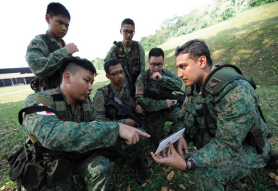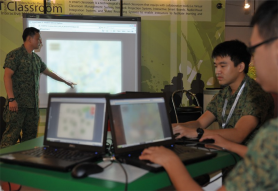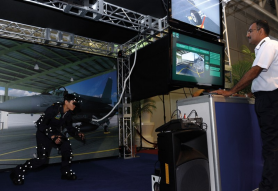OPS & TRAINING
TRANSFORMING LEARNING
13 Aug 2012

The Singapore Armed Forces' (SAF's) push to make training more efficient and effective has spawned some truly innovative ways to impart knowledge.
Just 10 years ago, becoming a soldier of the SAF meant hours in training sheds huddled with fellow trainees and trying to make sense of instructors' scribblings on clear plastic sheets draped over lesson materials. Trainees would then proceed to apply what they had just learnt out in the field.
Today, soldiers have portable devices which allow them to review lessons and learn at their own pace. At the Officer Cadet School, these tools have enabled instructors to enrich the curriculum, yet reduce classroom time.
"Even with the added curriculum, we were able to save about 10 percent of classroom time and use it instead for experiential learning in the field, which is essential to the SAF," said Lieutenant Colonel David Yeo, Head of Training and Learning Systems Branch, Headquarters Training and Doctrine Command (TRADOC).
This is one of the positive effects of the SAF-wide learning transformation. At its heart is the LEARNet system, an online platform which was officially launched by Minister for Defence Dr Ng Eng Hen at the inaugural SAF Learning Symposium held at SAFTI Military Institute on 28 Jun. LEARNet allows trainees to learn at their own pace and share their experiences.
Noted Brigadier-General Benedict Lim, Commandant of the SAFTI Military Institute: "The soldiers coming into the SAF today have been exposed to whole new ways of learning and it is incumbent upon the SAF to introduce platforms which are comfortable to them."
Smart learning space
At the Specialist Cadet School (SCS), instructors have been exploring the use of smart classroom technologies since 2006, imparting knowledge to Specialist Cadets (SCTs) through interactive "whiteboards".
Besides being able to present their lectures with videos and interactive graphics, instructors can instantly post questions to each trainee's learning station to ensure that the soldiers understand the lesson's key points. Lessons are recorded on video so SCTs can revisit them to clarify doubts.
One of the important lessons that every SCT learns is the planning of section tactical movements. In the past, these lessons were conducted with small printed maps wrapped in clear plastic, so that trainees could easily draw and erase military symbols that denote troop movements.
"With the smart classroom, we were...(able to show) them the larger picture. They are then able to see how their decisions can affect their parent unit and become better small unit leaders," said 2nd Warrant Officer (2WO) Peter Sim, Training Development Warrant Officer, SCS.
Beyond classrooms
Over at the Republic of Singapore Navy (RSN) Training Command (TRACOM), engineering instructors are teaching would-be ship engineers the finer points of the patrol vessel's, landing ship tank's and frigate's systems through the Platform Systems Emulator.
Detailed and realistic, the software allows trainees to manipulate valves and adjust engineering parameters found in ships' engine rooms and other engineering systems of RSN ships.
The software also emits and displays the appropriate audio and visual cues when something goes awry. Military Expert (ME) 3 Jake Tan, an instructor at the Platform Systems Training Centre, RSN TRACOM, explained: "It's like being in the ship itself, but without the accompanying hardware."
In the past, naval engineering trainees had to step on board the warships in order to get hands-on practice. "This posed several challenges, as the ships are not available for us to train on all the time," said ME3 Tan.
Learning virtually
Resembling something from a science-fiction film, the virtual reality training system that is used by the Republic of Singapore Air Force (RSAF) to train its Flight Line Crew requires the trainee to don a full suit which allows cameras to track his every movement. Corresponding images are then piped to a head-mounted display for an immersive 3D experience.
As the trainee moves around the virtual space, he is able to "touch" and "handle" various parts of the aircraft.
"With this system, trainees can perform the more repetitive tasks required for the safe launch and recovery of the F-16 fighter aircraft as many times as they need to gain confidence," said ME3 Karthikayan from the RSAF's Air Logistics Group - Fixed Wing.
He added: "As an instructor, I am now able to observe my trainees closely and step in immediately to correct them. This way, they will be better prepared for their roles in the operational units."
The RSAF will begin using the system in August, after taking delivery of two such systems in the same month.
Building resilience
It's not all military knowledge on LEARNet. One module teaches soldiers how to think positive!
Following the Building Resilience in Individuals for Growth and Emotional Well-being (BRIDGE) study conducted by the SAF's Psychological Care Centre (PCC) between 2007 and 2008, the Resilience Package was introduced on LEARNet.
The package teaches soldiers to re-frame their often one-sided perceptions of events. Each short lesson in the module addresses a specific area, ranging from boy-girl relationship issues to managing their own feelings about National Service.
Said Ms Dorothy Teo, a Psychologist at PCC: "One of the findings from the BRIDGE study was that soldiers who learnt to see events in perspective and remained positive, generally performed better at soldiering. They scored better in their physical and marksmanship tests, among other areas."
ALSO READ IN OPS & TRAINING

Exercise Wallaby 2025: To see better, shoot faster
31 Oct 2025
The SAF focuses on complex strike missions and multi-domain integration in Exercise Wallaby 2025, the 35th edition of its largest unilateral overseas exercise.

Ex Wallaby 25 – Greater Integration and Complexity
25 Oct 2025
The 35th edition of the SAF’s largest unilateral overseas exercise is an opportunity for expanded scale and deeper integration towards an effective, networked fighting force.

Ex Forging Sabre ramps up use of unmanned assets in integrated strike operations
12 Sep 2025
In this 10th edition of Exercise Forging Sabre, the SAF sharpened its cutting edge for the dynamic modern battlefield, with expanded integration between manned and unmanned platforms.





